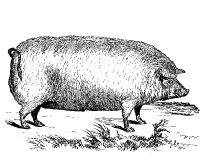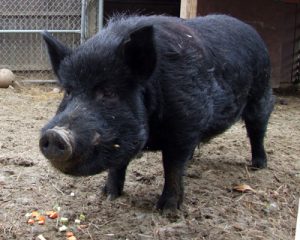How To Register American Guinea Hogs

Breed Facts
Condition:
Threatened
Apply:
Meat, Lard
Suckling BBQ
Charcuterie
Sausage/Ground
Lard/Dorsum Fatty
Developed Weight:
200-375 lbs. (male)
120-350 lbs. (female)
Hanging Weight:
threescore-230 lbs.
Temperament:
Docile
GUINEA Grunter
The American Republic of guinea Hog is a small-scale, black, landrace swine breed unique to the Usa. Prior to 2006, this pig was referred to every bit Guinea Hog, Republic of guinea Forest Squealer, or "yard grunter." The American Guinea Hog Association (AGHA) changed the brood name to American Republic of guinea Hog when the association was formed in 2006. It was known every bit the "poor human being'due south pig" and was raised on small farms in the southeast. Unlike imported breeds, there was no consistent organization of registration, herd books, or pedigrees retained on them consistently prior to 2006, although attempts to organize were made in 1956, 1988, and 1990.
Written records signal the presence of a local Guinea Hog breed every bit early as 1811. After 1840, the Guinea Pig was probable crossed with the Improved Essex, a solid black pig from Essex Canton England developed in 1840. Documents bespeak that Essex pigs were imported to Georgia and used to cantankerous-brood with local, coarser southern stock. The America Essex Association was formed, as evidenced past their third herd volume printed in 1896. In that clarification, it stated that some larger specimens of Essex reader 400 to 600 pounds. The breed in America was referred to every bit Essex.
Breeding-up programs for pigs were highly encouraged in Agronomical bulletins at land grant universities. It'south causeless that between 1845 and 1960, localized, unregistered Guinea Grunter populations were enhanced and influenced by American Essex boars. The phenotype of an Essex hog in the tardily 1800s – based on drawings and description – is remarkably like to the phenotype of some registered today'south American Guinea Hogs.
Typical American Guinea Hogs are solid black, as is the Improved Essex who influenced them. However, the breed may have also been influenced by Berkshire due to convenance-upward programs, the original Essex brood with a white listing (neck band) that produced the Improved Essex, and Chester Whites and Gloucestershire Old Spots, according to written history and DNA testing. Electric current 21st century breeders that do line-breeding or breed white marked Guinea Hogs with other Guinea Hogs with white markings accept produced more offspring with white marks since 2010. Some breeders like the "Berkshire" markings while others are concerned that these volition cause breed confusion with the Berkshire.
A condition called vitiligo besides occurs in the breed, causing hair to turn white, turning a black pig "blue" and turning the eyes blue. Sometimes this reverses as dramatically as it occurs. Historically there have been bluish Republic of guinea Hogs that were built-in blue who produced black or bluish offspring at birth. The last documented hog with this description was born in the 1990s in Georgia and his offspring, Browns Blue Boy, was bred by Baton Frank Brown in Mississippi. Some piglets are built-in with a reddish cast that fade to black before maturity. Some take cerise tinges to their ears or develop maroon shading or even look brilliant red before age 1 year. Inevitably these individuals mature as solid blackness or with cherry-red tinges only.
Characteristics
American Guinea Hogs are well-suited for raising in the forest, orchard, and pastured state. Homestead owners expect them to forage for much of their own food. This can include eating rodents, snakes, grass, roots, basics, garden beds after harvest, orchard windfall fruits, and corn stalks. Breeders that raise milk animals provide excess milk or whey to the pigs. Republic of guinea Hogs are hardy and efficient, gaining well on the roughest of fodder and producing the hams, salary, and lard essential for subsistence farming. They grow fatty when given grain, especially corn and soy. In nearly situations, a quart of feed twice a day will go on an developed boar or sow with weaned immature in adept status. Lactating sows with a litter require iii to four times more feed. Sweet feed and corn in general will put likewise much weight on this breed. Its fertility will be negatively affected by obesity. Monitoring trunk condition is essential to guide breeders in social club to increase or decrease inputs as needed. If boars, non-lactating sows, lactating sows and shoats are mixed within the same paddock, feeding cannot be efficiently managed. Dominant boars volition take food needed by lactating sows, for example, and piglets volition not get the nutrition they demand to grow.
A hallmark of the American Guinea Hog is temperament. The breed is known for intelligence, like shooting fish in a barrel trainability to fencing, verbal commands and routines, and for complying to boundaries set by the breeder. Sows typically permit their handlers to exist hands-on with piglets and boars are piece of cake keepers. Withal, it is imperative for breeders to control the environs and use caution effectually sows with newborns and boars effectually gilts or sows in heat. Animals that are overtly ambitious to humans should be culled.
Although they can reach sexual maturity as early equally 3-v months (male and female), the recommended breeding age is between 8-12 months for successful litters and mothering. The suggested age for a gilt'southward kickoff farrowing is between 12-14 months. Breeding twice a twelvemonth and earlier age two volition help fertility throughout the sow's life and provide the most meat/breeding stock/replacements for like inputs, providing value for the breeder's output overall
Females get into their heat (estrous) cycle every 12-21 days if not bred, beginning as early on as three months. Rut indicators are swollen vulva, discharge, and excitability. Gilts and sows in heat will mountain other gilts and sows. It is important to split intact shoats of dissimilar sexes by three months of age to preclude unintended convenance.
The number of teats on a sow range from 9-sixteen. inverted teats and less than twelve teats tin cause problems feeding piglets. Pigs' teats may vary from fifty-fifty, wide spacing to scattered, close spacing. Evaluate teats in both male and female pigs, equally boars provide half the genetics for female offspring. Wider spacing allows piglets easier admission to teats and greater survivability. The Sumrall bloodline has wider spacing than other lines.
Litter sizes tend to be between vi-x piglets, with eight being average. Adept survivability in litters of 6-ten. Some smaller sows produce litters of twelve to thirteen with 100% survivability. Smaller litters may be more consistent in size.
Sows will alive upwards to 14 years and raise viable litters from age one to age eight years. Some breeders have raised a sow to age ten or fifty-fifty twelve with viable litters. Boars will alive, brood, and produce feasible offspring to age 17. The longest living American Guinea Hog boar documented was 20-two years old and in a zoo setting.
Landrace Condition
It is important to note that this is a landrace breed, in an early stage of breed development. The breed was most prominent in southern states. Information technology was common in Florida, Georgia, Alabama, Mississippi, and Texas. Landraces are also known as local breeds or primitive breeds. "Landraces derive their unique genetic character from the usual combination of founder result, isolation, natural choice, and human selection" (Managing Breeds for a Secure Future: Strategies for Breeders and Breed Associations past Sponenberg, Martin, and Beranger, 2017).
Landrace breeds have standards written as a brood description. This allows for more variability than breed standards do for a standardized breed. Withal, inside the breed description, the breeder has a responsibility to select for the characteristics that make this hog indelible and appealing. These include hardiness, ability to forage, corking temperament and manageability, smaller size, dense black hair that offer lord's day protection, good mothering ability, hardy litters, high survivability to weaning, audio body blazon, lively movement, healthy feet, potent legs, and long life. Note the broad variability in size, meat production, litter size, and teats in the facts above. These have been strongly impacted by close inbreeding and choice practices among homesteaders. Now that the breed is distributed amidst the lower 49 states, information technology is important for breeders to thoughtfully consider selection criteria. In the 1990s, selection for small-scale size during a pet pig fad contributed to their near extinction. Pick for larger size and appearance like a Berkshire could atomic number 82 to a similar result due to breed confusion and interpretations of the breed standard.
Confusions of Brood Origin
The give-and-take Guinea has multiple meanings. It is often used to describe a atomic animate being, such as "Guinea Cattle," sometimes used for Florida Cracker Cattle, a relatively small brood that weighs only 500 pounds. In addition, Guinea is a republic in Africa. Republic of guinea fowl are owned to Africa. Guinea is also an old English language coin. When the rodents Guinea Pigs were brought from South America by sailors, their price was i guinea, according to some sources. Because of this confusion of meanings, American Republic of guinea Hogs were referred to at times equally African Woods Pigs.
Blood-red Guineas are a large, red hog imported to America, possibly from Africa, during the colonial catamenia as early as 1804 by Thomas Jefferson and other colonial farmers. During this time, African slaves were actively imported. Oral history conflated the slave trade with the Cerise Guineas, as they could take boarded the aforementioned ships. The Ruby-red Guineas from Africa share the confusing word Republic of guinea with the minor, blackness southern hogs. The similar proper noun created confusion for historians, as well.
Information technology is interesting to annotation that an obscure Virginia community named Guinea exists today but 140 miles from Monticello where the Red Guineas were raised. The proper name of the customs is as obscure to them every bit it is to today'south AGH breeders. The most usually told story is that during the Revolutionary War, Hessian mercenaries fighting for the British were housed in the area and paid in British guineas. There are also tales of sailors who were shipwrecked subsequently a voyage from Guinea in Due west Africa. Some other story is about country rented to farmers for one guinea a yr. (A Guinea Land of Mind by Jackie Nunnery, December 12, 2018 The Firm and Home Magazine online)
The signal of these examples is that the word guinea appears in many connotations for a wide variety of reasons. There is footling reason to believe that the large Cerise Guineas from 1804 are the same breed as the blackness Republic of guinea Hogs found in the United States as early every bit 1811. It is believed that Carmine Guineas helped to form the Duroc breed. Many new AGH breeders are on a mission to "bring back the cherry line of Guinea Hogs" without articulate evidence that there once was such a bloodline.
Several AGH breeders and historians are using Google Docs to locate references to Guinea Hogs prior to the Civil State of war, and comparing that to the history of the Improved Essex which has a similar phenotype to today'southward American Republic of guinea Hogs. That history will be fleshed out more fully sometime in 2021. It is apparent, though, that the Improved Essex hogs imported to the U.s. and popularly used to "improve" local, "coarser" breeds helped develop the at present registered American Guinea Hogs. Today, however, information technology is its own brood and uniquely American.
Did you know:
The Livestock Conservancy is America's leading organization working to save over 150 heritage breeds from extinction. We rely on the support of our members, grants, and donations from the public to raise the $700,000 a year needed to maintain our conservation piece of work with rare breeds of farm animals. Click here to learn how you can assist.
You may be interested in…
How To Register American Guinea Hogs,
Source: https://livestockconservancy.org/heritage-breeds/heritage-breeds-list/american-guinea-hog/
Posted by: earlcuposidere.blogspot.com




0 Response to "How To Register American Guinea Hogs"
Post a Comment